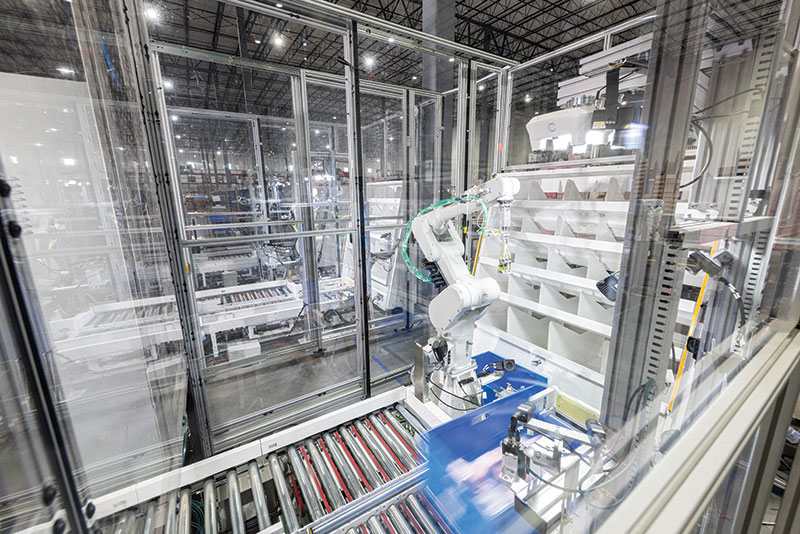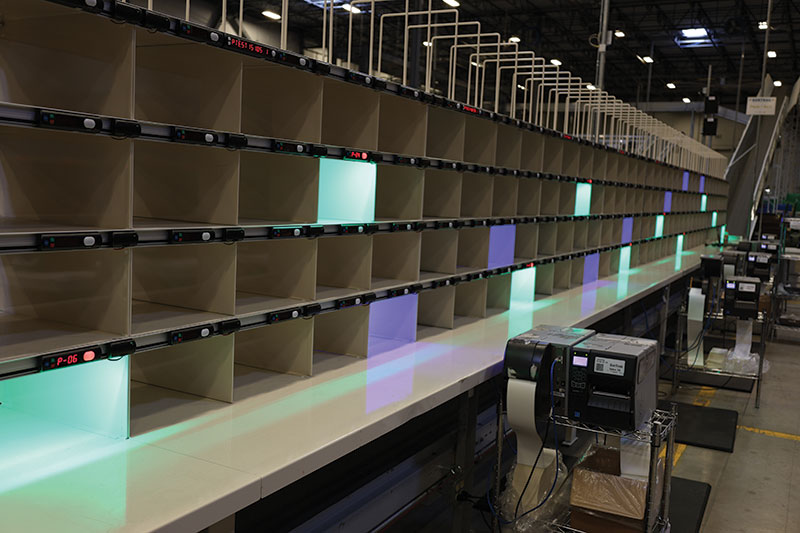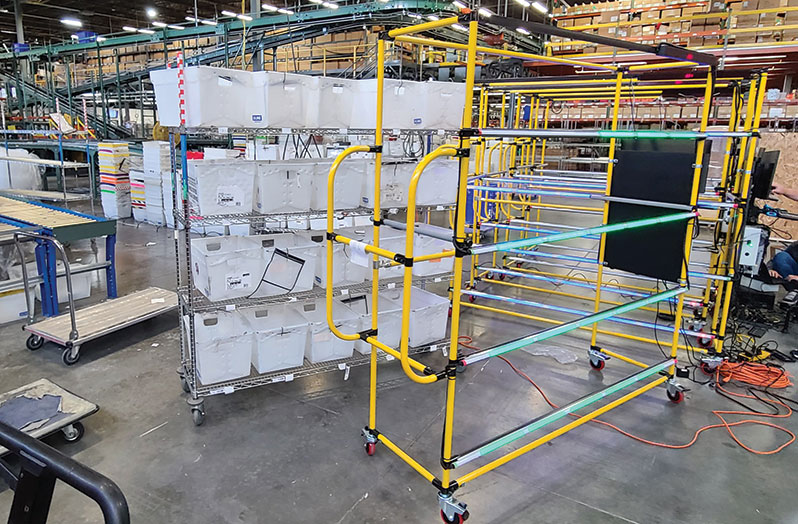播种墙有助于推动仓库的创新EN
Put walls help drive innovation in the warehouse
A look at how put walls are keeping pace with the rapid advancements in automation and robotics to help companies fill orders faster and more efficiently.
By Bridget McCrea July 11, 2023

With robotic put walls, a robot arm will pick up a single item from multi-SKU totes, and then scan and place the item into a compartment on a shelf.
As warehouses and DCs become more sophisticated, automated and advanced, the equipment within their four walls has also been keeping up. The surge in e-commerce mixed with the persistent labor shortage and then blended with vendor innovation has produced a host of new put walls that feature new designs and advanced technology that address companies’ current and future needs.
A type of warehouse racking system, a put wall is a place to “batch” work in relatively large fulfillment centers. Long, narrow walls made with individualized compartments—each of which holds a single order—put walls can cut down on the time it takes for an employee to walk back and forth between the packing area and the picking location. And because they provide dedicated spaces for each order, put walls can reduce errors like incorrect item placement.
Highly configurable, put walls can accommodate different types of orders, products and warehouse or DC settings. “Put walls exist to improve the efficiency of going to a pick location, picking as much product as possible and then fulfilling as many orders as you can,” explains Art Eldred, vice president and growth officer at VARGO. “The put wall facilitates the batch-picking process, which, when handled manually, translates into increased hourly labor costs.”
The latter is an important win for companies struggling under the weight of a persistent labor shortage and the subsequent increase in labor costs. By automating some or all of the picking and packing process, put walls can help companies fill labor gaps and operate more efficiently.
The uptick in e-commerce orders also comes into play here, as more organizations are being asked to ship smaller orders to individual customers faster than ever.
“E-commerce has driven the use of put walls, starting with Amazon and then [radiating] out across most of the e-commerce space,” Eldred says. “But at the end of the day, a put wall is really still just a cubby for quickly consolidating items that are all going to the same customer.”

An explosion of technologies
At heart they may just be cubbies where orders can quickly come together for packing and shipping, but put walls have been experiencing their own technological revolution over the last few years.
Driven in part by their own R&D and also by client demand, vendors are developing new solutions and improving upon existing solutions to meet market demand for more advanced, automated options.
“In terms of automation, we’re seeing an explosion of technologies that are being adapted to work in put walls,” Eldred points out.
Cache checking, or verifying whether a specific item is already stored in a cache, is being used to ensure that the right items are being placed in the put walls. Vendors are also working with robotics manufacturers to facilitate automated “item grabbing,” Eldred says, whereby robotic arms can be used to both identify and place the items in the put walls. VARGO’s Kindred Sort robotic piece-picking solution and its OPEX Sure Sort, which uses autonomous mobile robots (AMRs) and conveyors, were originally designed for mail sortation.
These automated options have since made their way into general warehouse and DC put walls, with a focus on moving items from one area to a specific destination. “It’s about automating the placement of an item from the induction point to the actual order,” Eldred describes. “This is being done at a very high rate of speed by extremely sophisticated robotics.”
Covariant’s head of product Adam Fry is also seeing what he calls a “significant push” to automate manual order sortation with robotic put walls. This is happening across a range of industries, including apparel, general merchandise, health and beauty, and pharmaceutical distributors.
“Given the current economic climate, the push to further automate manual put walls is happening more prominently within projects that improve the efficiency and throughput of brownfield sites,” Fry explains. “Rather than building net-new facilities from the ground up, companies are looking to retrofit their current manual order sortation or put wall footprint with new robotic solutions to gain efficiency and cut costs.”

With robotic put walls, a robot arm will pick up a single item from multi-SKU totes, and then scan and place the item into a compartment on a shelf. The robot arms can manage different shelving configurations that meet the needs of existing DC footprints. An arm can work with different configurations of put wall shelves (for example, in tight spaces the robots can place to a single shelf, or three shelves that surround the robot). It can also place items to mini mechanical “transporters” that move the picked item across a long linear wall of compartments for larger footprints and batch sizes.
Based on feedback he’s heard from Covariant’s retail and third-party logistics (3PL) customers, Fry says the drive to automate put walls is mainly being driven by the labor shortage.
“Workers for these roles are still hard to find—and even more difficult to keep—thus creating a throughput bottleneck in e-commerce operations,” says Fry, who sees more innovation ahead on the warehouse put wall front. One of the most promising advanced technologies right now is artificial intelligence (AI), which can be used to power very advanced, autonomous robotic put walls.
“Robotic put walls are able to sort millions of SKUs out of the box and handle them deftly with a level of precision that wasn’t possible even just a year or two ago,” says Fry. “With the latest advances in AI vision and camera technology, robots can [also] robustly avoid double picks and complete their grasping tasks with much higher reliability, even when picking objects from highly cluttered scenes.”
Additionally, Fry says recent advances in AI-based motion planning allow robots to control their acceleration to maintain their grasp of items under a variety of scenarios—all while keeping their speed of performance high.
“Robotic put walls also now combine these AI advances more smartly with traditional sensors [i.e., light curtains] to have a highly accurate understanding of which items went where to maintain the highest level of standards on order accuracy,” Fry adds.
Mother-child and hybrid put walls
Put wall makers continue to come up with innovative designs to meet customers’ current needs and to help prepare those operations for the future. At FastFetch Corporation, president John C. Peck says the company’s mother-child put wall carts and its new hybrid options are gaining good traction in the warehousing and fulfillment industry.
The mother-child cart incorporates a frame (the “mother”) that’s equipped with electronics and a cart (the “child”) that does not. The child holds the totes, boxes or other types of containers, while the mother is equipped with LED lights, electronics and other features. Most totes or containers—plus the child cart itself—are bar coded and the box that’s adjacent to the LEDs lights up. Then, the whole combined solution can be taken to the packing area.
“Even if the cart didn’t have a bar code, the employee can scan a tote and know which batch that tote belongs to,” Peck explains. “When the cart gets to the packing area, it’s scanned in and the employee knows what the order is, what size box to use and so forth.”
Peck says FastFetch also recently introduced a hybrid put wall that reduces the number of product touches to one (for 80% of the products being picked) or two (for the rest of them).
“In most cases, 80% of picking involves 20% of a company’s products, so having 20% of your most popular products in one place for picking is ideal,” says Peck. With hybrid put walls, carts are rolled right to the front of the slotted area, where someone picks the products and puts them in the boxes using a pick-to-light system.
Peck says the company is also integrating more programmable logic controllers (PLCs) and conveyors into its put wall solutions. “We’re doing a lot of work in this area right now,” he adds.

What’s next?
Peter Gerbitz, systems sales manager at Matthews Automation Solutions, sees more integration between robotics, automation and put walls on the near horizon.
As more organizations invest in goods-to-person technology like automated storage and retrieval systems (AS/RS) and mini-shuttles, the “element of sortation” that has to happen at the end—prior to the order being sent out the door—is often best handled by put walls.
Within the put walls themselves, Gerbitz is seeing more put-to-light technology and other options being infused in the equipment, which is being built to integrate well with other solutions.
“Put walls can still function as stand-alone solutions with traditional batch picking and sorting the batches into individual orders, but they’re also working more and more in conjunction with other solutions,” says Gerbitz, whose firm recently introduced bin illumination options that use mounted LED light strips versus bulbs for put-to-light applications. He says some customers are asking for projection-type picking that incorporates a projector that’s mounted above a work cell and illuminates the start location (and also provides operation information).
To companies shopping for new put walls or upgrading existing systems this year, Fry says to use “careful diligence” during the research phase, particularly if robotic put walls are on your shopping list. Ideally, robots will reliably pick and sort a significant percentage of the SKUs running through your warehouses (99%+) at a consistently high speed (400 PPH+) with minimal errors (<0.1%).
“Robotic put wall solutions also need to be complete end-to-end products, not just robot arms—integrating into the routing of batch totes in a facility, working with existing pack workflows and having clear insight into order statuses,” says Fry. “The best way to test this when evaluating new robotic put wall providers is to run a performance benchmark: Send them a sample of your items and see how their solutions perform out-of-the-box and improve over a short period of time.”

全部 0条评论